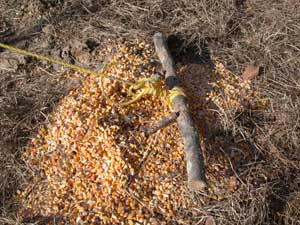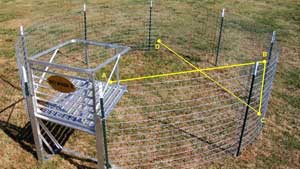Trigger Mechanisms
Root Sticks
 Root Stick with Bait
Root Stick with Bait
Setting It Up
The root stick consists of two sections of rebar (reinforcing bar) or two sticks called set stakes driven into the ground at a 45-degree to 60-degree angle (with the ends pointing away from the trap door). A length of rope or cord is attached at one end to the drop door and at the other end to the middle of a strong stick or piece of scrap lumber, called the root stick.
How It Works
The door is held open by wedging the root stick behind the set stakes. Bait is placed around and on top of the root stick, and the trap is sprung when feeding and rooting pigs push the root stick out from behind the set stakes. Note: The root stick trigger is dependent upon gravity and is best suited for use with a sliding drop door.
Trip Wires
 Corral Trap Trip Wire
Corral Trap Trip Wire
The trip wire is a line or wire strung across one corner or the rear section of the trap, run around one side of the trap, and attached to a triggering device (pin, hook, or prop stick) on the trap door.
When stringing the trip wire from the trap door to the rear section of the trap (the point at which it will change direction and cross the width of the trap), position the line or wire high enough so that the backs and heads of adult pigs will not disturb it and spring the trap too soon.
How It Works
Once sufficient pressure is exerted on the line or wire, the trigger device releases the door and the trap is sprung. The amount of pressure required to spring the trap can be adjusted by tightening or loosening the trip wire.
When using a multicatch trap door, a trip wire works best. The action needed to pull the prop from the saloon-style door or to release the door panels on the root door work much more smoothly and reliably with the trip wire. Note: Trip wires used with saloon-style doors and root doors should be one continuous length.
Trip Wire Placement
To reduce incidents of the trap being sprung early by nontarget species, such as raccoons and opossums, suspend the trip wire across the rear section of the trap 16 inches to 20 inches above the ground. Suspending the trip wire at this height will also help reduce the chances of younger and smaller pigs springing the trap too soon.
Root Sticks vs. Trip Wires
Both the root stick and trip wire are proven triggering mechanisms for trapping wild pigs. However, because of their varying levels of trigger sensitivity there are times when it may be more tactful to use one versus the other. Whereas trip wires are more sensitive to disturbance, root sticks are less so and require more effort on the part of pigs and nontarget species to spring the trap. If pigs seem to be purposefully avoiding the root stick trigger or soils are too loose or too compacted to use a root stick, then a trip wire is the better option. See the figures below for converting a root stick to a trip wire.

